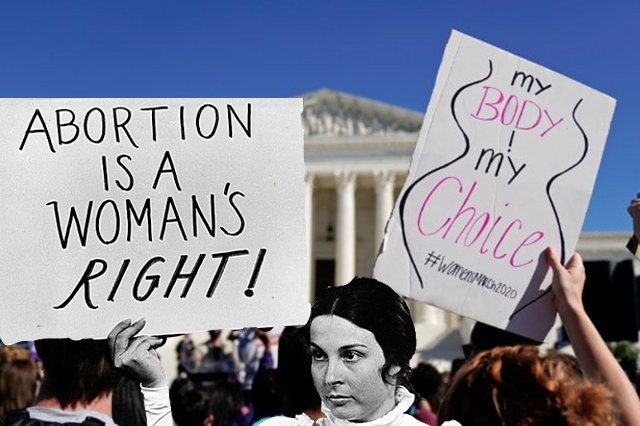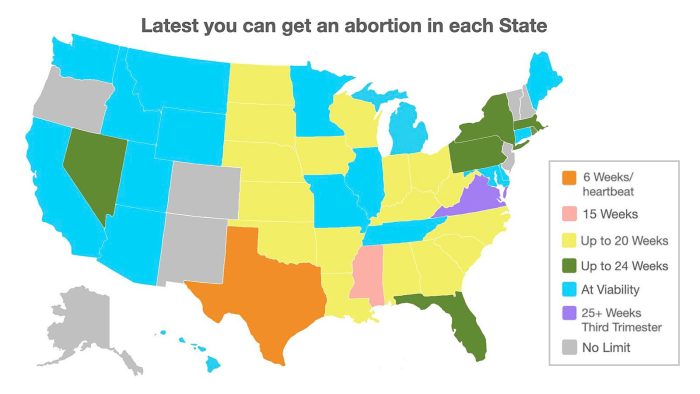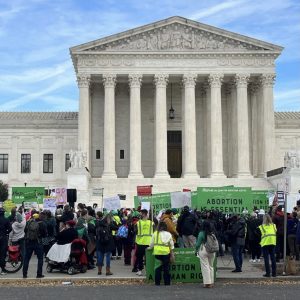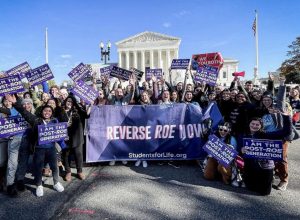
Vaccine controversy, soaring gas prices, a resurgence of indie rock, the fall of a foreign capital after a decades-long proxy war — oh, and a controversial clash in the Supreme Court that could cost women their right to an abortion.
Is it the 1970s or 2020s?
For Macy Meinhardt, the fear that this battle could end with her being forced “to give up control of her own body and her own future” is very much a 2021 reality.

“There’s nothing democratic about that,” said the junior journalism major.
It’s been almost 50 years since Roe v. Wade, the historic Supreme Court case that secured a woman’s constitutional right to an abortion before “fetal viability,” or about 23 weeks. But numerous challenges to the case have proven that the controversy is far from decided.
One such challenge saw its first Supreme Court arguments Dec. 1.
Dobbs v. Jackson Women’s Health Organization stems out of a Mississippi law which seeks to ban abortions after the 15-week mark, as opposed to Roe’s precedent of 23 weeks.
It is the most direct challenge to Roe’s ruling in decades. If upheld, it could reverse the 1973 decision and see effects across at least 20 states almost immediately.
“I feel like our country has overall been moving in a more progressive direction in terms of societal values, so to see Roe v. Wade successfully get overturned would be a huge back track,” said Meinhardt. “I just don’t see how we would evolve in any way from it.”
But the Mississippi law hasn’t been the only one to make headlines in the past few months.

An anti-abortion bill passed Sept. 1 in Texas banned abortions after the six-week mark. The kicker: it bars state officials from actually enforcing it, leaving the power to private citizens, which makes the bill difficult to challenge in court.
The Supreme Court opted not to block the law based on this nuance, effectively allowing the ban of abortion after six weeks across about 24 Texas clinics.
As a reference, six weeks pregnant basically means a woman is two weeks late for her period.
For pro-life supporters, the Supreme Court’s failure to block the law “has shown that the states need not adopt a posture of learned helplessness in response to questionable or unconstitutional court rulings,” said Jonathan F. Mitchell, the lawyer behind the carefully crafted bill, in a statement obtained by The New York Times.

But for Savannah Sauer, a senior dance major originally hailing from Houston, it’s “frustrating” knowing people from her home state might be “negatively affected” by the decision.
“Any element of choice has been taken away from women in Texas,” said Sauer.
Meinhardt, also a Houston native, echoed the sentiment:
“Texas is my home and so much of my heart lies there, but it is growing into a place where I don’t feel safe anymore, in terms of my rights as a woman.”
With a conservative majority, including recent appointees Justice Brett Kavanaugh and Justice Amy Coney Barrett, the Court appears to lean towards upholding the Mississippi law’s restrictions, too.
“By taking away someone’s ability to choose, [those seeking abortions] are going to resort to obtaining more options in an unsafe way,” Sauer said.
Statistically speaking, banning abortion outright doesn’t actually stop abortions. It just stops the safe ones.

According to a 2017 news release from the World Health Organization (WHO), in countries where abortions were either banned or heavily restricted, one in four abortion procedures were considered safe.
However, in countries where abortions are at least somewhat legal, nine out of 10 abortions were performed safely.
Bela Ganatra, a reproductive health scientist at WHO and the lead author of the study, said, “When women and girls cannot access effective contraception and safe abortion services, there are serious consequences for their own health and that of their families.”
Meinhardt emphasized that this issue in the Supreme Court isn’t just a matter of abortion rights, but rather women’s rights as a whole.
“It is an issue that relates to the power and control women have over their own bodies,” said Meinhardt. “The laws that are currently trying to decrease and limit that right reflects the hesitation of allocating that power to women – which ultimately reinstates why we still need to fight for equality.”
The Supreme Court’s decision is expected to come in late June or early July 2022. In the meantime, both pro-life and pro-choice organizations have taken to the streets.
Women’s March, one of the leading voices for women’s rights issues, held a demonstration held Dec. 1 in Washington, D.C., describing their stance as, “Holding the line for abortion justice.”

Also demonstrating at The Marble Palace was Students for Life, an organization uniting high school and college students across the country under the slogan: “We Are the Post-Roe Generation.”
Though Students for Life did not respond for comment, the organization wrote in a Dec. 1 Instagram post, “Roe’s days are numbered… and we are sooo here for it.”
A Gallup poll from May showed 32% of Americans are in favor of abortions being legal under any circumstances, 48% are in favor of abortions being legal only under certain circumstances, and 19% said they would like to see abortions illegal in all circumstances.
The remaining 2% had no opinion on the matter.
Another poll by Pew Research Center more specifically reported that those age 18-29 are most likely to support abortion being legal in all or most cases – about 67% of the age group.
Furthermore, about two-thirds of college graduates, 68%, support abortion access.
On Chapman’s campus, Sauer said, “I don’t think many students are aware of this issue. I am truly only aware because I’m from Texas.”
Meinhardt agreed, and encouraged fellow students to read, inform, and educate themselves, “because it’s a tricky subject that has a lot of moving parts.”
With the Supreme Court not slated for announcement until the middle of next year, students will likely see a lot of hot debate on the topic in the coming months.
Said Meinhardt:
“People are never going to see eye to eye on this issue, our only option is to compromise and that takes listening to one another.”


Megan J. Miller is a senior studying journalism and documentary film. When she isn’t writing, you can find her working on her ’95 Bronco, exploring new hiking trails, or scouring the thrift stores for the best vintage finds.
Megan J. Miller is a senior studying journalism and documentary film. When she isn't writing, you can find her working on her '95 Bronco, exploring new hiking trails, or scouring the thrift stores for the best vintage finds.
